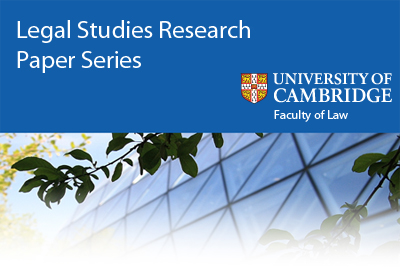 The Faculty has published Volume 4 Number 11 of the University of Cambridge Faculty of Law Legal Studies Research Paper Series on SSRN.
The Faculty has published Volume 4 Number 11 of the University of Cambridge Faculty of Law Legal Studies Research Paper Series on SSRN.
This issue includes the following articles:
Neil H. Andrews: Money and Other Fundamentals: English Perspectives on Court Proceedings, Mediation, and Arbitration (37/2013)
This article examines the modern 'squeeze’ upon court proceedings. England remains committed to attracting cross-border contentious legal work. The administrators of the courts system and of mediation and arbitration bodies share the goal of improving civil justice in all its forms. Mediation is increasing in importance; the system of arbitration also continues to prosper because it is an attractive alternative to court litigation. Mediation is to be encouraged because, when the conditions are right, it offers an attractive alternative to both the processes and outcomes of court and arbitral adjudication. The delicate interplay of arbitration and court support and supervision requires English judges to remain in close contact with the arbitration world. But court litigation has been in the doldrums because it remains very expensive and public support for legal aid has been greatly reduced. Reforms introduced in April 2013 state that when the losing party is required to pay the victor’s costs ('recoverable costs’), the amount must be proportionate to the case’s importance and value.
Sarah Nouwen: The Diverging Conflict Analyses of the United Nations and the African Union (44/2013)
International legal scholarship on the African Union has focused on the question whether international law allows the AU to intervene militarily in its member states in the absence of authorization by the UN Security Council. The reality of recent practice, however, has revealed the opposite scenario: the AU has often not intervened, even when not only its own Constitutive Act, but also international law on the use of force more generally, allowed it. Indeed, in some situations, the African Union opposed the intervention that the UN had authorized. These remarks made at the Annual Conference of the American Society of International Law explore one possible explanation. It argues that differences in views between the United Nations and the African Union on how to resolve crises in Africa have stemmed from the different lenses through which they have looked at these crises. The different lenses explain disagreements between the AU and the UN about how a conflict is framed. As a result of different framing, the AU and UN differ in their analyses of the conflict and in their theories of change, in other words, in how the situation can be transformed from one of conflict into one of (relative) peace.
Matthew Dyson: Tort and Crime (48/2013)
This chapter will set out how the distinction and relationship between tort and crime can be examined comparatively. To do so it gives a framework to prime investigations and to facilitate comparison. It builds on three interfaces of tort and crime: where, how, why they connect. Progressing through these interfaces builds up layers towards a complete picture of the relationship between tort and crime.
The relationship between tort and crime is important. Each legal issue, and the legal system as a whole, is better understood by acknowledging when its parts work in concert not by artificially separating them out. Its interfaces also highlight how important legal actors’ frameworks and practices are in shaping the law. The interfaces between tort and crime provide excellent places to examine the weave of the law: the moral, regulatory, philosophical, political, practical and societal threads, as well as how these feed back to the way the problem is conceived. We are asking, in other words, what the overlaps between areas of law can tell us about law itself.
Valia S.G. Babis: European Bank Recovery and Resolution Directive: Recovery Proceedings for Cross-Border Banking Groups (49/2013)
The EU bank recovery and resolution directive includes mechanisms for recovery (or “early intervention”) for groups. These are: group recovery plans, intra-group financial assistance and coordination of early intervention measures regarding groups.
But do these group provisions ensure a consistent recovery procedure for the entire banking group across borders? While recovery tools applicable to more than one group affiliate are part of the EU regulatory framework, use of such tools across borders depends on the discretion of supervisors of group affiliates. Recovery tools can only apply across group affiliates if supervisors reach joint decisions and make use of recovery tools in a consistent, cooperative and coordinated manner across the group. This means that the effectiveness of group recovery depends greatly on the institutional architecture of supervision in the EU, and in particular, the relationships between supervisors within and beyond the SSM.
Brian R. Cheffins, Steven A. Bank, Harwell Wells: Law and History by Numbers: Use, But with Care (50/2013)
This paper, prepared for a University of Illinois College of Law symposium honoring Prof. Larry Ribstein, deals with the historical development of corporate law in the United States, focusing on the promise and perils of quantification. The paper is part of a larger project where we have already deployed the “anti-director rights index” (ADRI), a well-known mechanism for quantifying the protection various nations’ corporate laws offer investors, to “score” Delaware corporate law from the turn of the 20th century to the present day (http://ssrn.com/abstract= 2079505). We are currently expanding our research by investigating two additional bodies of corporate law (Illinois and the Model Business Corporations Act) and by taking into account as a second measure of corporate law an “anti-self-dealing index” (ASDI) that focuses on regulation of transactions between a company and those who control it. We identify in this paper various reasons for undertaking a quantitative, historically-oriented analysis of U.S. corporate law. The paper focuses primarily, however, on the logistical challenges associated with such an inquiry. We indicate that it is impossible to code U.S. corporate law historically with clinical precision but nevertheless conclude that the quantification exercise in which we are currently engaging should provide sufficient insights to be worthwhile.
Interested readers can browse the Working Paper Series at SSRN, or sign up to subscribe to distributions of the the e-journal.


 Facebook
Facebook  X/Twitter
X/Twitter  Instagram
Instagram  YouTube
YouTube  Flickr
Flickr  LinkedIn
LinkedIn